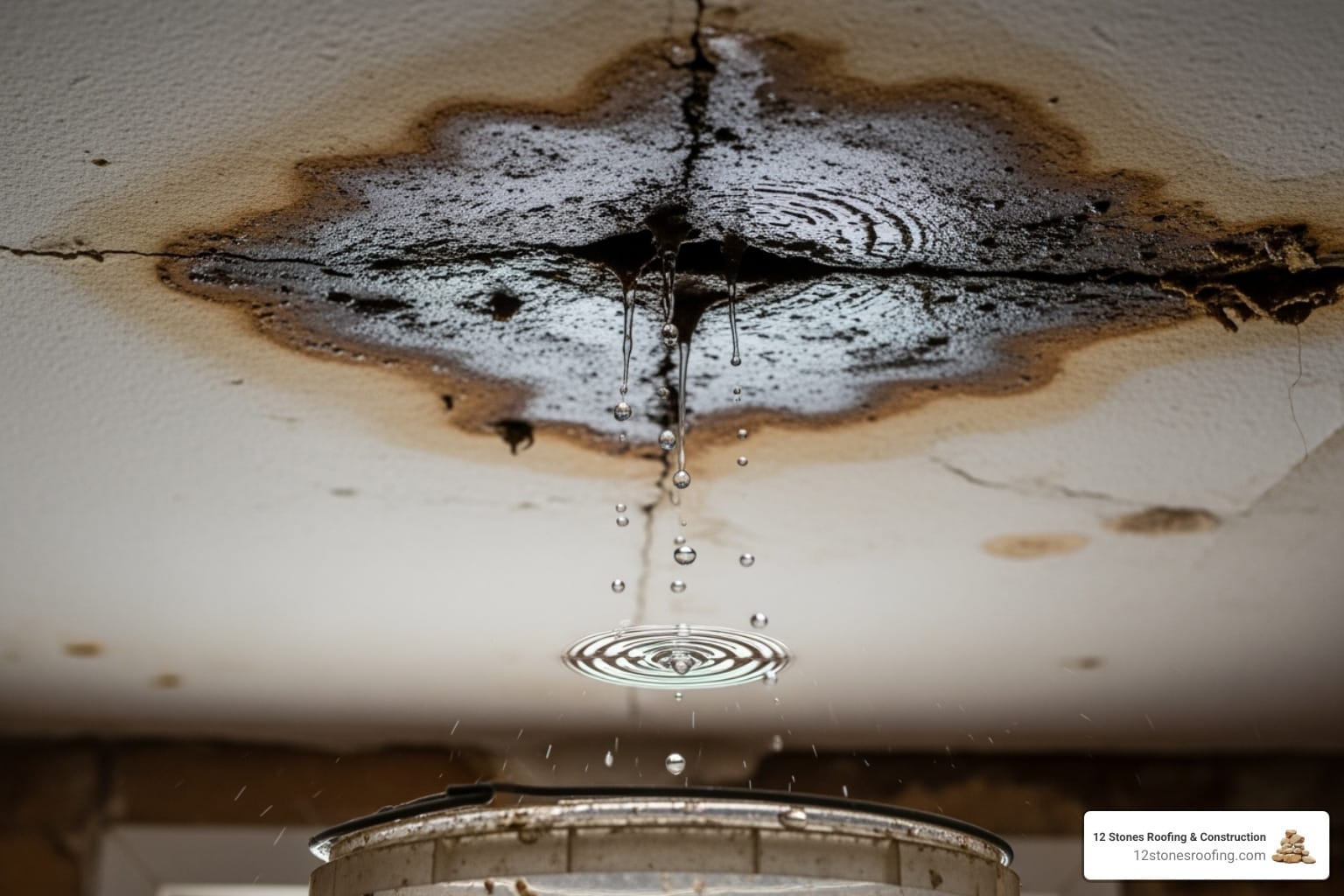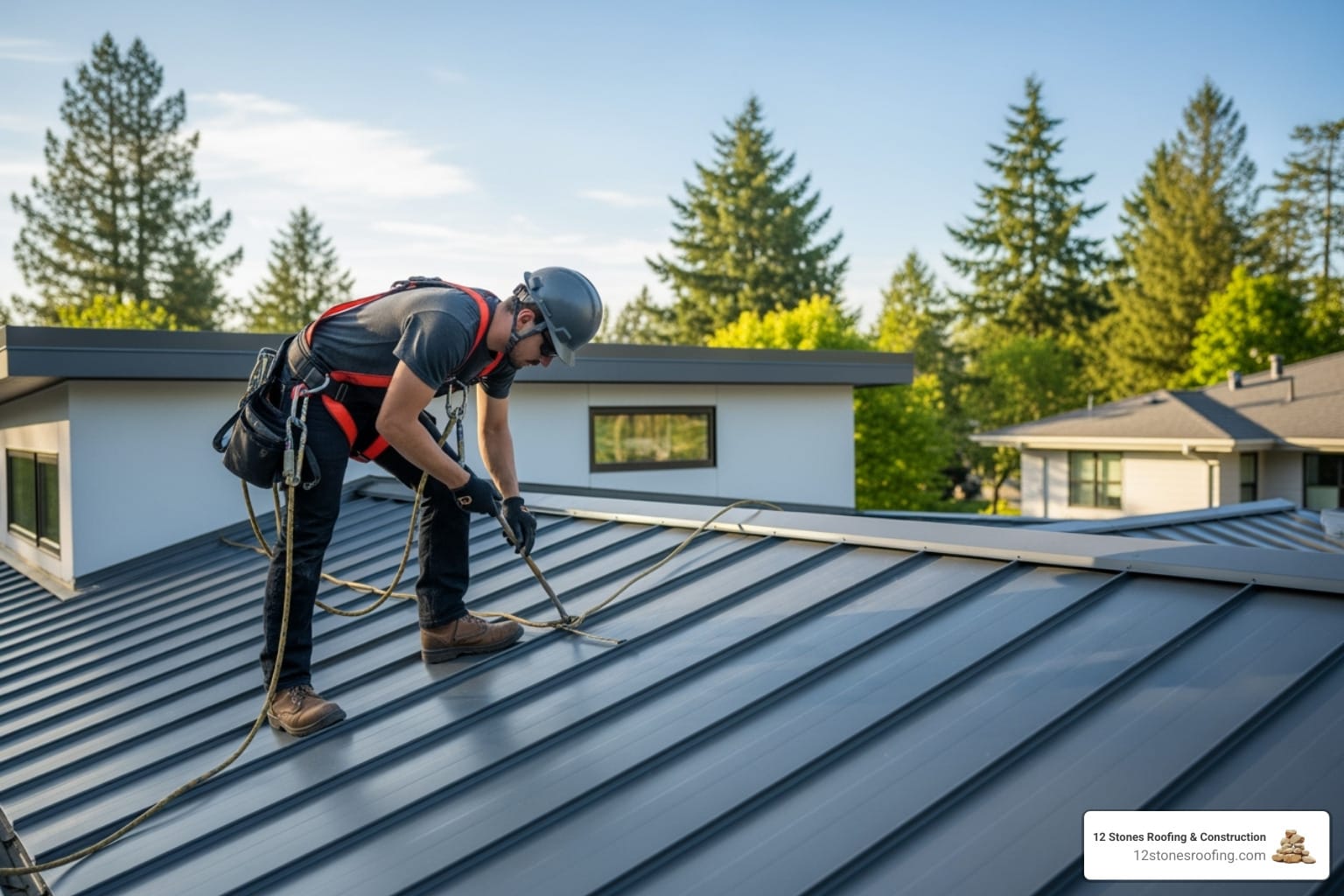Why a Lightweight Conservatory Roof Transforms Your Home
A lightweight conservatory roof is a modern roofing system that replaces traditional glass or polycarbonate conservatory roofs with insulated, solid materials that weigh significantly less than conventional tiles. Here’s what you need to know:
Key Benefits:
- Year-round comfort – Maintains comfortable temperatures in all seasons
- Energy efficiency – U-values as low as 0.10 compared to 1.6W/M2K for polycarbonate
- Durability – Average lifespan of 20-50 years with 40-year warranties
- Quick installation – Typically completed in 2-3 days
- Structural compatibility – Light enough for existing conservatory frames
Common Materials:
- Synthetic composite tiles weighing under 20kg per square meter
- Lightweight steel shingles with weather-resistant coatings
- Insulated panel systems with integrated thermal barriers
If your conservatory feels like an oven in summer and an icebox in winter, you’re experiencing the classic problems that drive homeowners to upgrade. Traditional conservatory roofs create extreme temperature swings, high energy bills, and spaces that sit unused for months at a time.
As experts in residential roofing solutions, we understand how the right roof transforms not just comfort, but your entire living experience. This comprehensive guide covers everything you need to know about upgrading to a lightweight conservatory roof system.
I’m Jason Roberts, owner of 12 Stones Roofing & Construction, and over the past decade I’ve helped countless Gulf Coast homeowners transform their conservatories with lightweight conservatory roof installations that deliver lasting comfort and value. My team specializes in advanced roofing systems that stand up to Texas weather while maximizing energy efficiency.
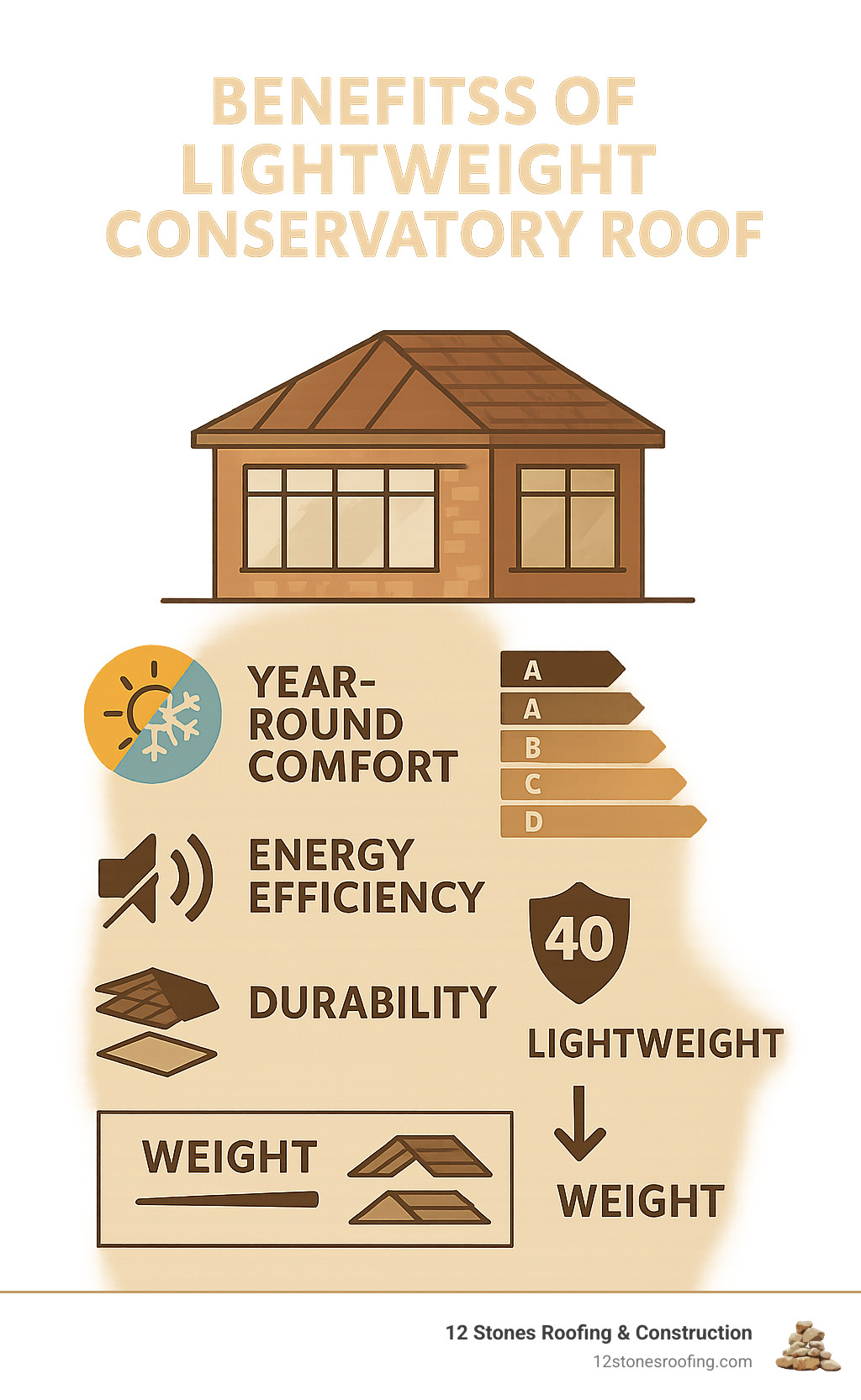
Why Your Old Conservatory Roof Fails: Common Problems with Glass and Polycarbonate
If you’ve ever walked into your conservatory on a blazing summer afternoon only to feel like you’ve stepped into an oven, you’re not alone. That beautiful glass or polycarbonate roof that seemed like such a great idea? It’s creating what we call the greenhouse effect – trapping heat when you least want it and letting it escape when you need it most.
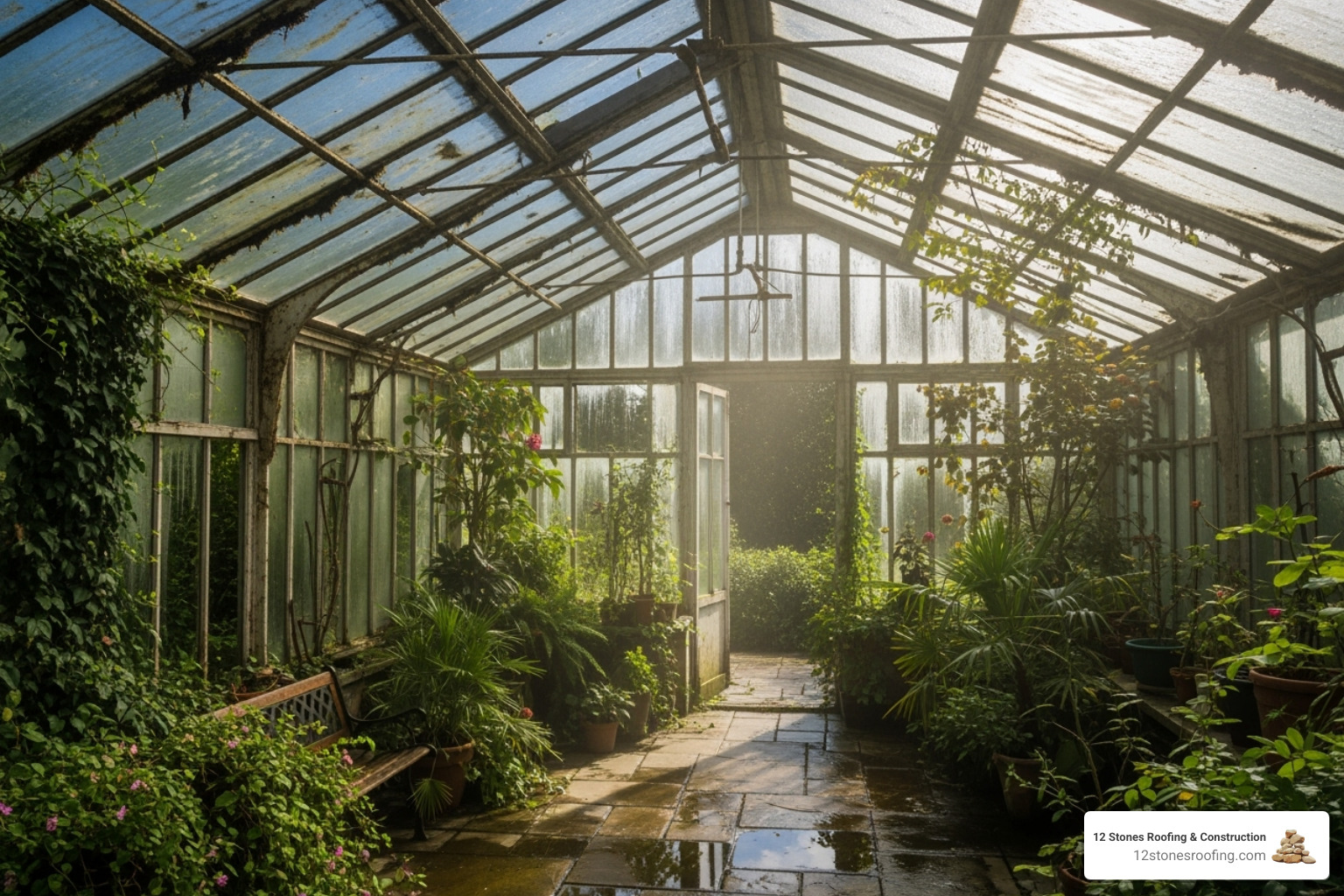
The truth is, traditional conservatory roofs simply weren’t designed with modern comfort in mind. While they look attractive and let in plenty of natural light, they create a host of problems that make your space uncomfortable and expensive to maintain.
Extreme temperatures are the biggest culprit. During Texas summers, glass and polycarbonate roofs turn your conservatory into an unbearable heat trap, with temperatures soaring well above the rest of your home. Come winter, the same roof becomes a heat sieve, creating winter cold that makes the space unusable for months at a time.
But temperature isn’t the only issue. Anyone who’s tried to have a conversation during a rainstorm knows about the loud noise from rain and hail that polycarbonate roofs create. What should be a peaceful retreat becomes a drum concert every time the weather turns.
Leaks and condensation issues plague older conservatory roofs as seals deteriorate over time. That moisture doesn’t just create puddles – it leads to mold, mildew, and damage to your furniture and flooring. The constant cycle of heating and cooling also causes materials to expand and contract, creating gaps where water can sneak in.
Then there’s the sun glare and UV damage to consider. While natural light is wonderful, the intense glare can make it impossible to read or watch TV comfortably. Worse yet, those powerful UV rays are slowly fading your furniture, artwork, and carpeting, shortening their lifespan significantly.
Perhaps most frustrating of all are the high energy bills from heat loss and gain. Your HVAC system works overtime trying to compensate for a roof that’s essentially working against it. It’s like trying to air condition your yard – expensive and ultimately futile.
This is exactly why so many homeowners are making the switch to a lightweight conservatory roof system. Instead of fighting these problems year after year, a solid roof upgrade transforms your conservatory from a seasonal headache into a comfortable, year-round living space.
The Solution: Over 5 Key Benefits of a Lightweight Conservatory Roof
Picture this: It’s a scorching July afternoon in Texas, but your conservatory feels perfectly comfortable. Or imagine enjoying your morning coffee there on a chilly December day without needing a winter coat. This isn’t wishful thinking – it’s exactly what happens when you upgrade to a lightweight conservatory roof.
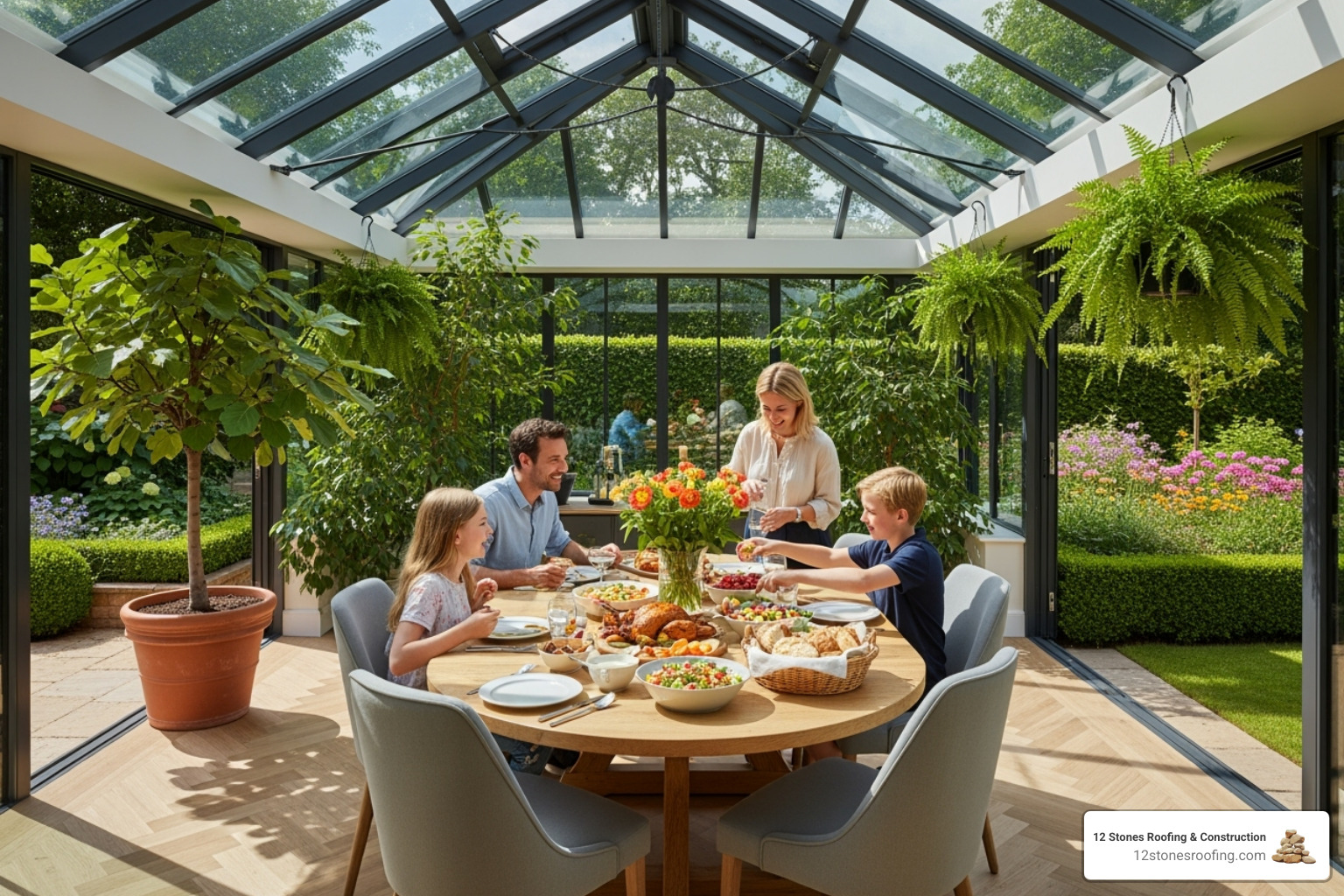
The change is remarkable. Where you once had an unusable space for half the year, you now have a comfortable room that works every single day. Let me walk you through the game-changing benefits that make this upgrade so worthwhile.
Superior thermal performance is hands-down the biggest win. These advanced roofing systems deliver U-values as low as 0.15, compared to the dismal 1.6W/M2K of standard polycarbonate roofs. What does this mean for you? Your conservatory finally maintains comfortable temperatures year-round, whether it’s blazing hot or freezing cold outside.
The energy savings that follow are impressive. When your conservatory isn’t fighting against extreme temperatures, your HVAC system doesn’t have to work overtime. Many of our clients see noticeable drops in their monthly energy bills after installation. It’s like getting paid back for your investment, month after month.
Gone are the days of deafening rain drumming on your roof. The solid construction of a lightweight conservatory roof creates a peaceful, quiet space where you can actually have a conversation during a thunderstorm. No more feeling like you’re inside a tin can during Texas downpours.
Your home’s curb appeal gets a major boost too. These roofs come in various styles and finishes that seamlessly match your existing home. Instead of that dated, yellowing polycarbonate look, you get the appearance of a permanent, high-quality room extension that improves your property’s overall aesthetic.
The durability factor is where this upgrade really shines as a smart investment. While traditional conservatory roofs typically last 10-20 years and are prone to damage, lightweight systems are built to withstand decades of Texas weather. Many come with 40-year warranties, giving you peace of mind for the long haul.
Harsh sun glare becomes a thing of the past, making your space comfortable for reading, watching TV, or working on your laptop. Plus, the solid roof blocks harmful UV rays that fade furniture and damage your belongings over time.
Perhaps most importantly, you’re adding genuine living space to your home. This type of roof replacement is a long-term investment in your home’s comfort and value. You’re not just fixing a roof – you’re reclaiming an entire room that can serve as a dining area, home office, or peaceful retreat.
The bottom line? A lightweight conservatory roof transforms a problematic space into one of your home’s most enjoyable rooms. It’s an upgrade that pays dividends in comfort, savings, and property value for years to come.
Types of Lightweight Roofing Materials and Key Considerations
When you’re ready to upgrade your conservatory, understanding your material options makes all the difference. The good news? Modern lightweight conservatory roof systems offer the perfect blend of performance and beauty, giving you that traditional look without the weight problems.
Common Materials for a Lightweight Conservatory Roof
Today’s lightweight conservatory roof materials are pretty impressive. They’re engineered to look exactly like traditional roofing while being light enough for your existing conservatory frame to handle safely.
Synthetic slate tiles have become incredibly popular, and for good reason. These clever composites are made from materials like virgin limestone and polypropylene, creating tiles that look just like natural slate but weigh a fraction of the amount. They’re tough as nails too – designed to handle everything from Texas hailstorms to falling branches without missing a beat.
Lightweight steel shingles offer another excellent choice. These systems use high-grade steel that’s been specially treated for weather resistance. What I love about steel options is their interlocking design, which makes installation smoother and creates a rock-solid, weatherproof finish. Plus, they come in various profiles and colors, so matching your home’s style is never a problem.
Composite panels represent some of the most advanced technology in conservatory roofing. These systems combine materials like glass reinforced plastic for structure with insulated boards for thermal performance. The result? A lightweight conservatory roof that delivers superior insulation – often with U-values as low as 0.14 – while maintaining that seamless, finished look you want.
All these materials share key advantages: exceptional weather resistance, impressive durability, and a wide variety of colors and finishes. This means you can choose a roof that not only performs beautifully but also perfectly complements your home’s existing look.
How to Choose the Right Lightweight Conservatory Roof
Picking the right lightweight conservatory roof involves more than just choosing a material you like. You want to make sure your investment delivers long-term value and performance.
| Metric | Lightweight Tiled Roof | Glass Roof | Polycarbonate Roof |
|---|---|---|---|
| Thermal Insulation (U-Value) | Excellent (0.10 – 0.15) | Moderate to Good (1.2 – 2.0, with double/triple glazing) | Poor (1.6 – 3.0) |
| Average Lifespan | 20 – 50 years (with 40-year warranties common) | 20 – 30 years | 10 – 20 years |
| Noise Insulation | Excellent (significantly reduces rain/hail noise) | Moderate (can still be noisy during heavy rain) | Poor (very noisy during rain/hail) |
| Initial Cost | Higher than polycarbonate/basic glass, lower than traditional extension | Moderate to High | Lowest |
Durability and warranty should be at the top of your priority list. The best manufacturers back their products with impressive 40-year warranties, which tells you everything you need to know about their confidence in the materials. When you’re investing in a lightweight conservatory roof, you want something that’ll handle decades of Texas weather without breaking a sweat.
Structural integrity is absolutely critical. Your existing conservatory frame wasn’t designed to support heavy traditional tiles, which is exactly why lightweight systems exist. A proper structural assessment ensures your chosen system works safely with your current frame. These systems are specifically engineered to weigh about the same as a glass roof while delivering far superior performance.
Cost-effectiveness goes beyond the initial price tag. Yes, a lightweight conservatory roof costs more upfront than basic polycarbonate, but think about the bigger picture. You’ll save money on energy bills month after month, avoid replacement costs for decades, and actually be able to use your conservatory year-round. It’s one of those investments that keeps paying you back.
Building code compliance has gotten much simpler in recent years. Before 2010, conservatory roofs had to be mostly see-through, but regulations have evolved. Now you can install solid conservatory roofs without planning permission, as long as they meet specific criteria. Working with experienced contractors who understand current building standards keeps you on the right side of regulations and ensures your upgrade adds genuine value to your home.
Installation and Building Regulations: What to Expect
The thought of changing your conservatory might feel overwhelming, but here’s the good news: installing a lightweight conservatory roof is surprisingly straightforward and won’t turn your home into a construction zone for weeks on end.
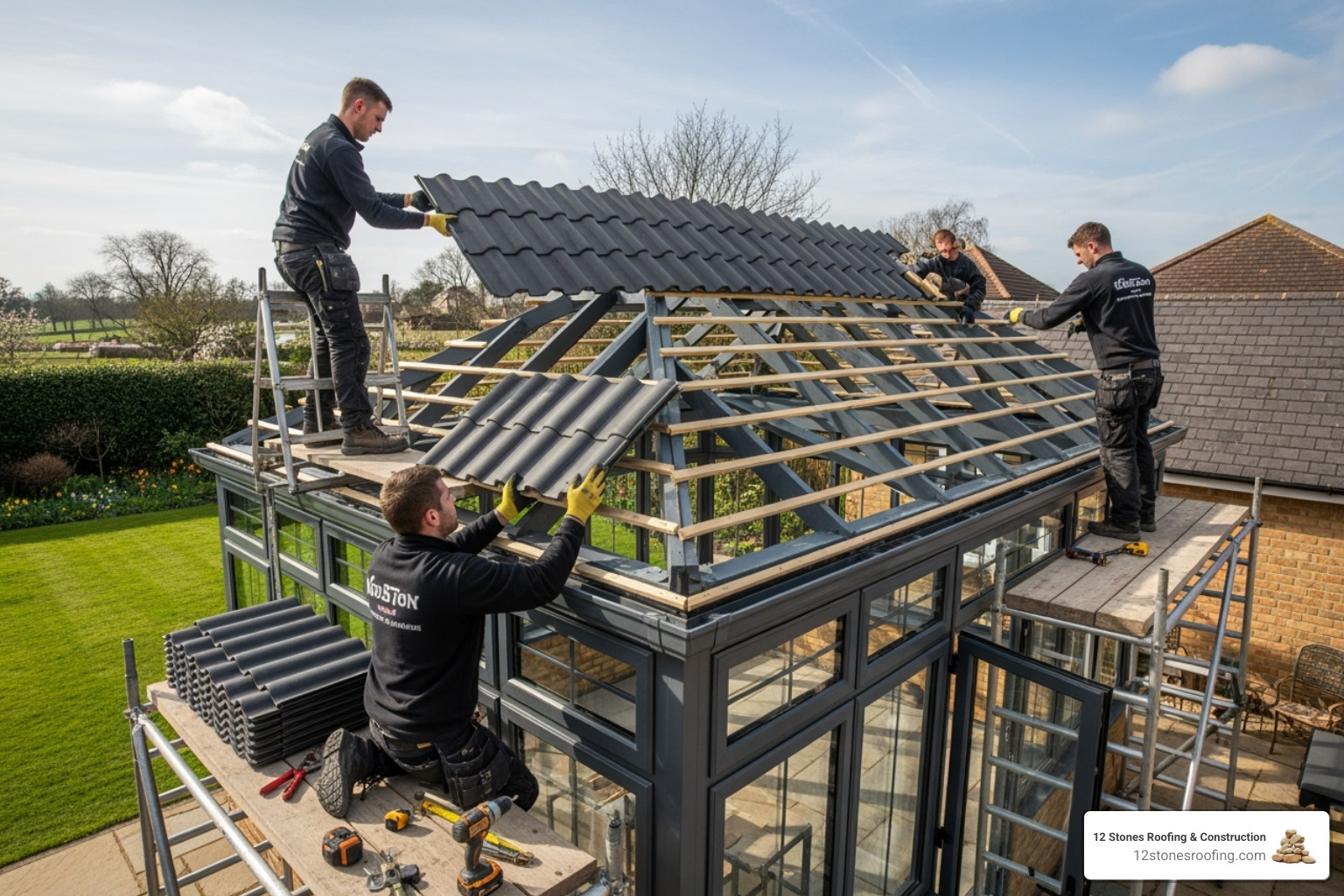
Most lightweight conservatory roof installations are completed in just 2-3 days, including removing your old roof and installing the new system. Some advanced systems can even be made watertight in around 6 hours! This quick turnaround means you’ll be enjoying your transformed space almost before you know it.
The secret to this efficiency lies in the pre-fabricated design of modern lightweight systems. Everything arrives ready to install, which dramatically reduces on-site cutting, mess, and disruption to your daily routine. You won’t need to relocate to a hotel or avoid entire areas of your home during the installation.
Before any work begins, though, our team conducts a thorough structural assessment of your existing conservatory frame. While these lightweight systems are engineered to work with most existing structures, we need to verify that your frame can safely support the new roof. This isn’t just about following regulations – it’s about ensuring your family’s safety and protecting your investment for decades to come.
Understanding the regulatory landscape can feel confusing, but here’s what you need to know: since 2010, many solid roof conversions don’t require planning permission if they meet specific criteria. However, building code compliance remains essential. These codes ensure your new roof meets standards for structural integrity, thermal performance, and safety.
Professional installation isn’t just recommended – it’s crucial for getting the full benefits of your lightweight conservatory roof. The conversion involves complex considerations around structural support, insulation layers, and precise weatherproofing. A qualified installer manages every detail, from initial assessment through final completion, ensuring your investment delivers the comfort and energy savings you’re expecting.
Navigating Building Codes in Pasadena, TX
Living in Pasadena means dealing with unique weather challenges, from intense summer heat to occasional severe storms. Our local building requirements reflect these realities, and understanding them is essential for any major home improvement project like a lightweight conservatory roof conversion.
While the general principles of lightweight roofing apply everywhere, Pasadena has specific local requirements that can impact permits and inspections. What works in other states might not automatically meet our local standards, especially given the demanding weather conditions we face here in Texas.
This is where local expertise becomes invaluable. At 12 Stones Roofing & Construction, we’ve spent years mastering Pasadena’s building codes and developing relationships with local inspectors. We handle all the regulatory paperwork and ensure your project meets every requirement from day one.
Choosing a contractor who truly understands local regulations isn’t just about avoiding headaches – it’s about protecting your investment and ensuring your family’s safety. We’ve seen too many homeowners struggle with compliance issues because they worked with contractors unfamiliar with local requirements.
12 Stones Roofing & Construction
Address: 6933 Olson Ln, Pasadena, TX 77505
Phone: (832) 815-9463
Frequently Asked Questions about Lightweight Conservatory Roofs
We get lots of questions from homeowners who are excited about changing their conservatories but want to make sure they understand what they’re getting into. Here are the most common questions we hear, along with honest answers based on our years of experience:
Can a lightweight tiled roof be installed on any conservatory?
Here’s some great news – almost every conservatory can be upgraded with a lightweight conservatory roof! These systems are specifically designed to work with existing frames, no matter what style you have.
Whether your conservatory is a cozy lean-to, an neat Victorian or Edwardian design, or even a more complex P-shaped configuration, these roofs are engineered to fit. The magic is in that “lightweight” part – they’re designed to weigh about the same as your current glass or polycarbonate roof, so your existing frame can handle the load without expensive structural work.
That said, we always start with a thorough structural assessment. It’s like getting a checkup before starting a new exercise routine – we want to make sure everything is ready to perform at its best. This step ensures your new roof will be safe, secure, and built to last.
How much does a lightweight conservatory roof cost?
This is probably the question we hear most often, and I wish I could give you a simple answer! The truth is, lightweight conservatory roof costs vary quite a bit based on several factors.
Size matters – a small lean-to will cost significantly less than a large Victorian conservatory. Material choice also plays a role, as premium synthetic slate tiles cost more than basic composite panels. Installation complexity can affect pricing too – factors like roof access, the condition of your existing frame, and any special features you want (like skylights or integrated lighting) all influence the final cost.
Here’s what I tell all my customers: yes, the initial investment is higher than simply replacing polycarbonate with more polycarbonate. But think about what you’re really getting – dramatically lower energy bills, a space you can actually use year-round, and a roof that won’t need replacing for decades. When you factor in the long-term savings and increased home value, it’s an investment that truly pays for itself.
How long do lightweight conservatory roofs last?
This is where lightweight conservatory roofs absolutely shine compared to traditional options. If you’ve dealt with a polycarbonate roof that’s yellowed, cracked, or become noisy over time, you’ll love this answer.
While polycarbonate roofs typically start showing their age after just 10-20 years, a quality lightweight conservatory roof is built for the long haul. We’re talking about an average lifespan of 20 to 50 years, with many systems designed to last even longer.
The warranties tell the whole story – leading manufacturers back their products with 40-year guarantees. That’s not just confidence in their product; it’s peace of mind for you. When you invest in one of these roofs, you’re likely looking at the last conservatory roof you’ll ever need to buy.
This durability means you won’t be dealing with another costly replacement project for decades. Instead, you’ll be enjoying a comfortable, quiet, energy-efficient space that adds real value to your home year after year.
Conclusion: Transform Your Conservatory into a Valuable Living Space
If you’ve made it this far, you’re probably already imagining the possibilities – sipping your morning coffee in a comfortable space that’s neither freezing nor sweltering, hosting dinner parties without worrying about the weather, or finally having that quiet home office you’ve always wanted. A lightweight conservatory roof isn’t just another home improvement project; it’s your ticket to reclaiming a space that may have been sitting unused for months at a time.
Think about it: instead of that frustrating room that’s too hot in summer and too cold in winter, you’ll have a comfortable, quiet, and energy-efficient living area that works for you every single day of the year. No more avoiding your conservatory during Texas heat waves or shivering through winter mornings. You’re essentially gaining an entirely new room without the massive expense and months-long disruption of a traditional home addition.
The numbers speak for themselves. With U-values as low as 0.10 compared to polycarbonate’s disappointing 1.6, you’re looking at dramatic energy savings that add up month after month. Factor in the 20 to 50-year lifespan with those impressive 40-year warranties, and suddenly the initial investment makes perfect financial sense. You’re not just buying a roof; you’re making a smart long-term investment that pays dividends in comfort, utility bills, and home value.
At 12 Stones Roofing & Construction, we’ve seen how a lightweight conservatory roof transforms not just spaces, but entire lifestyles. We specialize in high-quality roofing solutions that protect your property while genuinely improving how you live in your home. Our expertise in selecting and installing the ideal system means you can trust us to handle every detail, from structural assessment to final inspection.
Ready to turn that underused conservatory into the room you actually want to spend time in? We’re here to make it happen. If you’re prepared to make this smart investment and open up your conservatory’s full potential, let’s explore a professional roof replacement with our expert team. Your year-round comfortable conservatory is just one conversation away.



